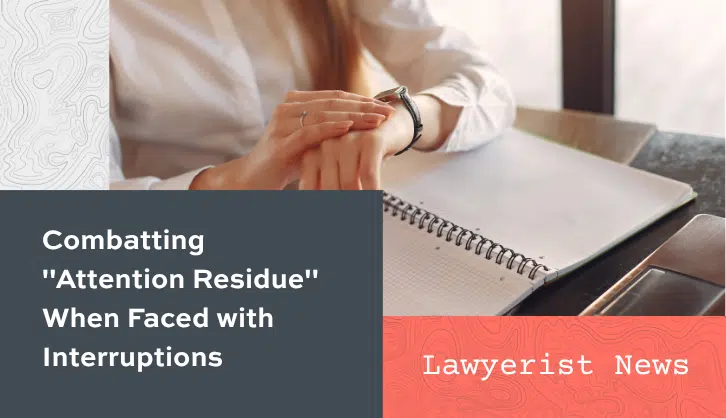
Modern work is full of interruptions…from urgent emails from clients to calls to colleagues seeking feedback. These interruptions fragment our time and attention. A study published in the Harvard Business Review by professors Sophie Leroy and Theresa M. Glomb found that professionals are interrupted about every 6 to 12 minutes on average. Each interruption forces a change in mental context that can leave part of our attention still “stuck” on the initial task, a phenomenon that Leroy calls “attention residue.”
Essentially, attention residue means that part of your mind continues to preoccupy itself with the previous, unfinished task even as you try to focus on the new one. This residual attention impairs performance. You only use part of your cognitive abilities for the task at hand, which can lead to missed details, poor decisions, and difficulty returning to the original work. For people who juggle multiple topics and deadlines, attention residue invisibly drains your efficiency.
The plan ready to resume: a simple solution
Leroy and Glomb’s research suggests a practical intervention to combat attention residue: the Ready to Resume plan. I’ve always called this: “Write down where you left off and what’s next.” » The “plan” is extremely simple and quick. When something or someone interrupts you in the middle of a task, take a moment to briefly note where you left off and what you intend to do next on that task. Essentially, you leave yourself a roadmap for your return, a short list of next steps, remaining challenges, or next action to take upon your return. This small investment of time allows for cognitive closure, reassuring your brain that the initial task will be completed later, so it can safely put it aside for the moment. By explicitly marking your place and plan, you give your brain “permission” to completely disengage from task A and focus on task B.
Main findings
Leroy and Glomb tested the loan-to-resume strategy in a series of experiments relevant to high-stakes decision making. Participants in a laboratory study were given an initial task and then interrupted with a secondary task. One group was asked to quickly write a ready-to-resume note on the original task before switching, while a control group switched tasks without any such plan. The results are striking and highly relevant to the constant change many of us face every day.
Reduction of “attention residue” and better concentration
Those who created a plan ready to resume showed significantly less attentiveness during the interruption task. They were able to focus more on the new task at hand, while the no-plan group’s performance on the interruption task suffered (indicating that their attention was divided).
Improved decision quality: 79% more likely to make the optimal decision
Those who created a ready-to-resume plan for their original task were 79% more likely to correctly choose the best candidate, which was the study’s measure of optimal decision, compared to those who did not plan.
Easier return to original tasks
Participants who had developed a ready-to-resume plan were significantly more likely to resume and successfully complete their original task after the interruption.
Why it’s important: Much of our work often involves managing multiple files, deadlines and unforeseen client needs simultaneously. The cognitive cost of interruption (attention residue) can be particularly detrimental when details and good judgment are paramount. The ready-to-resume technique directly addresses these problems by preserving concentration and continuity.
Recommendations
Pause and plan (even for 30 seconds)
Whenever an interruption occurs, take a brief break to note your status on the current task. Write a one-line summary of what you were doing and the next step you intended to take. If you are the person interrupting someone else, extend professional courtesy and remind them to take the time they need to note where they left off and their next steps. If you are the person interrupted, tell the speaker that you are just taking a moment to note where you left off and the next steps.
Give the interruption your full attention
Once you have your note ready to resume, fully commit to the interruption task.
Sources
Leroy, S. & Glomb, TM (2020). “A plan for managing (constant) work interruptions.” Harvard Business Review (June 30, 2020).
Leroy, S. & Glomb, TM (2018). “Interrupted Task: Examining the Effects of Work Interruptions on Attention and Performance” (Organization Science).
Neilson, K. (2020). “How to combat attention residue.” HRM Online – Australian Human Resources Institute.
Last updated July 25, 2025





